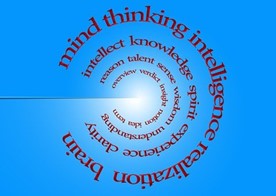Essay #3: What’s the Story?

WHAT’S THE STORY?
Based on my research, the three most effective ways the human brain learns are:
Trial & Error
Games (PLAY)
Stories
Of these three, other mammals share with us the first two. Trial & Error? The first time we as infants curiously touch a hot stove is probably the last time.
Scientists studying songbirds noted the young birds learned more from trial & error than by just observation. The advantages animals have over us is they are free to learn from trial and error whereas our school system metes out bad grades for mistakes, pressuring students to avoid them.
“By seeking and blundering we learn.”
― Johann Wolfgang von Goethe
One of the most cheerful, witty and smart encouragements for students to learn from blunders came in a letter written by the great novelist/satirist Kurt Vonnegut. In 2006, a teacher at Xavier High School in Manhattan, a Ms. Lockwood, challenged her students to write a letter to their favorite author and invite him or her to visit the class. Five of the students chose Kurt Vonnegut. He was the only author to respond.
Here is his letter:
“Dear Xavier High School, and Ms. Lockwood, and Messrs. Perin, McFeely, Batten, Maurer and Congiusta:
I thank you for your friendly letters. You sure know how to cheer up a really old geezer (84) in his sunset years. I don’t make public appearances anymore because I now resemble nothing so much as an iguana.
What I had to say to you, moreover, would not take long, to wit: Practice any art, music, singing, dancing, acting, drawing, painting, sculpting, poetry, fiction, essays, reportage, no matter how well or badly, not to get money and fame, but to experience becoming, to find out what’s inside you, to make your soul grow.
Seriously! I mean starting right now, do art and do it for the rest of your lives. Draw a funny or nice picture of Ms. Lockwood, and give it to her. Dance home after school, and sing in the shower and on and on. Make a face in your mashed potatoes. Pretend you’re Count Dracula.
Here’s an assignment for tonight, and I hope Ms. Lockwood will flunk you if you don’t do it: Write a six-line poem, about anything, but rhymed. No fair tennis without a net. Make it as good as you possibly can. But don’t tell anybody what you’re doing. Don’t show it or recite it to anybody, not even your girlfriend or parents or whatever, or Ms. Lockwood. OK?
Tear it up into teeny-weeny pieces, and discard them into widely separated trash receptacles. You will find that you have already been gloriously rewarded for your poem. You have experienced becoming, learned a lot more about what’s inside you, and you have made your soul grow.
God bless you all!
What a brilliant tribute to the right hemisphere of our brains.
Human Brain Vs. Computer Brain: What Can We Learn?

After trial & error, the second of the most effective ways our brains learn comes from playing games, which we also share with other mammals. Watching puppies, squirrels and tiger cubs playing is one of the most enjoyable scenes we experience, but there are deep hunting and life-saving learning patterns being developed at the core of play.
For us humans, as the 20th century was shifting towards the 21st, expanding computer intelligence upped the ante as to what we can learn from playing games with the new form of intelligence we created: Computer intelligence (AI).
This was made dramatically clear in 1997 when IBM’s Deep Blue computer beat the reigning human world chess champion, Gary Kasparov. It shocked the chess world. Kasparov was considered the greatest human chess player of all time. He had easily defeated Deep Blue just a few years before. But Deep Blue, with help from its human programmers, learned at exponential speed. As it engaged in the rematch with Kasparov, Gary was able to calculate 12-14 moves ahead under pressure, a great feat for a human brain. Across the chess board, according to information on the IBM web site, “Deep blue could explore up to 200 million possible chess positions per second.” And pick out the one most effective.
But it was more than just sheer, massive calculations that shocked Kasparov to his core. As he later said in an interview for Time Magazine,
“I could feel — I could smell — a new kind of intelligence across the table.”

To try and soften the wound to human egos, a number of game enthusiasts back in 1997 rationalized that while chess is primarily a game of speedy calculations in a well-defined territory with well-defined potential moves, a computer would never beat the best humans at GO, the Asian game much more complex than chess which requires not just memory and speed calculations, but more mysterious qualities such as the subjective inner voice of “intuition” which a purely calculating machine could never match.
Those critics were proven wrong.
In March, 2016, in front of over two million keenly interested online spectators from around the world, the computer AlphaGo developed by Deep Mind, a British subsidiary of Google, easily defeated 8-time world GO champion Lee Sedol.
This freaked out the game world even more than Kasparov’s defeat. Here’s an excerpt from the report of the outcome on the New Scientist web site at the time:
“As the game reached its conclusion, the reality of Lee’s defeat set in slowly across the venue, prompting quiet gasps of shock. This was stark contrast to Tuesday, when some Korean journalists had openly cheered Lee at a press conference.
The news, that artificial intelligence has defeated humanity’s best Go player, has sent shock waves through the international Go community. ‘I felt emotional and dizzy, and stepped outside for a minute,’ said Ben Lockhart, one of the top US amateur players, watching on in the press room.”
Another commentator saw the defeat as even more apocalyptic:
“It was hard not to feel sympathy with Lee as I watched this opening defeat. He carries the hopes of a nation – not to mention a species – on his shoulders.”
At one point early on in the first match, AlphaGo made a surprising move, one not seen before in the long history of recording top level Go games. Lee Sedol, confused and a bit shaken by the unanticipated move, took one of the allowed breaks and left the room.
One of the media commentators, a world-class GO player himself, reporting the match to the millions watching, stated, “I don’t really know if it’s a good move or a bad move.”
His fellow commentator announced, “I thought it was a mistake.”
Another world-class player watching the match described the computer’s move with a word we reserve for subjective, emotional human qualities, not rational, calculating ones. He described the computer’s move as “Beautiful. So beautiful.”
Hours later, Lee Sedol, admitting he was “shocked,” resigned.
Cad Metz, reporting the match for Wired Magazine, responded to that “beautiful” move:
“It was the moment AlphaGo proved it understands, or at least appears to mimic understanding in a way that is indistinguishable from the real thing. From where Lee sat, AlphaGo displayed what Go players might describe as intuition, the ability to play a beautiful game not just like a person but in a way no person could.”

An Even Bigger SURPRISE
As “shocking” as a computer able to beat a human at a game requiring what are considered subjective, inner mind skills , it could still be rationalized somewhat by the fact that AlphaGo had the advantage of 30 million moves by top level human GO players inputted into its memory and which it could access in seconds at any time.
But then some very smart folks at Google came up with a brainstorm—what if, instead of inputting any human games into a computer, it simply gave the computer the rules of a game and then have it LEARN only by playing itself millions of times? (In other words, learn by trial & error, given the fancier term “reinforcement learning,” without any knowledge of how the most skillful humans in history played the game).
By 2017, computers were running at such fast speeds that one named AlphaZero (zero knowledge of how the best humans played the games) learned chess, GO and another complex Asian game, Shogi.
Learning chess, it only took AlphaZero a few hours to play against itself millions of times and analyze the most successful strategies. That was the sum total of its learning curve. A match was set up between Alpha Zero and the strongest chess computer program in the world at the time called Stockfish.
Here is an enjoyable description of the two computer chess opponents from an article in Popular Mechanics:
“On one side was Stockfish 8. This world-champion program approaches chess like dynamite handles a boulder—with sheer force, churning through 60 million potential moves per second. Of these millions of moves, Stockfish picks what it sees as the very best one—with “best” defined by a complex, hand-tuned algorithm co-designed by computer scientists and chess grandmasters. That algorithm values a delicate balance of factors like pawn positions and the safety of its king.
On the other side was a new program called AlphaZero (the “zero” meaning no human knowledge in the loop), a chess engine in some ways very much weaker than Stockfish—powering through just 1/100th as many moves per second as its opponent. But AlphaZero is an entirely different machine. Instead of deducing the “best” moves with an algorithm designed by outside experts, it learns strategy by itself–Its programmers merely tuned it with the basic rules of chess and allowed it to play several million games against itself. As it learned, AlphaZero gradually pieced together its own strategy.”
Note those portentous words about this form of computer learning: “gradually pieced together its own strategy.” Once the rules of the game were inputted and instructions given to engage in a massive trial & error learning process, humans were being taken out of the learning loop
The result? As reported by Popular Mechanics:
“The head-to-head battle was astonishing. In 100 games, AlphaZero never lost. The AI engine won the match (winning 28 games and drawing the rest) with dazzling sacrifices, risky moves, and a beautiful style that was completely new to the world of computer chess.”
(Note: At the highest level of human chess, most games are drawn, neither player winning. To win 28 out of 100 and lose none against the most successful computer chess engine in the world at the time was astonishing.)
So, what does this brief history of computer intelligence playing games have to do with the right hemisphere of the human brain and helping to bring about the Next Renaissance?
4 Takeaways
- AlphaGo’s remarkable achievement is confirmation of one of media theorist Marshall McLuhan’ key aphorisms: “The medium is the message.” By playing against itself and learning what moves best achieved the goal of the game, then soundly defeating the chess program that in seconds could access and compare a data base of 60 million human chess moves by the greatest human players of all time, Alpha Zero showed that the underlying “process” or “medium” of learning is more powerful than analyzing the best content available. (for deeper look into this oracular aphorism and some of its potential meanings for us here in the 21s century Digital Age).
- The chess journalist writing for Popular Mechanics, William Herkewitz, analyzing the novel, brilliant strategy of AlphaZero, describes it: “Again and again, this magician-like chess engine makes early sacrifices like these as part of an extremely long-term strategy whose benefit won’t become clear for dozens of moves into the future.” This strategy is similar philosophically to some of the greatest human psychological and spiritual teachers with regards to “sacrifice” and the “bigger picture” of what is most beneficial in the long run.
- Virtually all media observers viewed the stunning defeat of Gary Kasparov by Deep Blue in 1997 as a blow to the human ego and limited their view of games to that of a “zero-sum game,” a game in which in order for one person or team to win, the other person or team has to lose. But Kasparov, after initially displaying his bruised ego by angrily accusing IBM of cheating, came to a “Big Picture” perception some twenty years later, writing in the Wall Street Journal,“It is no secret that I hate losing, and I did not take it well. But losing to a computer wasn’t as harsh a blow to me as many at the time thought it was for humanity as a whole. The cover of Newsweek called the match “The Brain’s Last Stand.” Those six games in 1997 gave a dark cast to the narrative of “man versus machine” in the digital age…Twenty years later, after learning much more about the subject, I am convinced that we must stop seeing intelligent machines as our rivals.”
- As confirmation of Kasparov’s “big picture” insight, the intelligence built into Deep Blue to defeat him is now being used to help doctors solve difficult and puzzling cancer cases. As doctors work with computers to solve complex cases, the human ego had to go through more gyrations. As one male doctor admitted his initial reactions to Deep Blue’s diagnostic skills, ‘Oh my God, why didn’t I think of that?’ We don’t like to admit it.” How Watson is Transforming Health Care
The Metaphorical Learning Tool: Stories

If someone uses the phrase “sour grapes” or “slow and steady wins the race,” we immediately tap into the meaning behind those phrases which emerge from two of Aesop’s fables written over 2,000 years ago. Teaching tales have immediate and enduring learning power. One famous example:
A Zen student is quite pleased with the progress he feels he’s making, especially after being invited to have tea with the Zen master. The teacher pours himself some tea, then starts pouring some into the student’s cup. He keeps pouring until the hot liquid spills over and onto the lap of the student who jumps up angrily. The Zen master looks down at the overflowing cup and says to the student, “Your mind is like that cup.”

The pessimistic takeaway from Big Blue demoralizing the human world chess champion and AlphaGo shocking the Go game world is that it signals computers are taking over the world and will eventually make human intelligence negligible.
But there’s a story which points to a very different conclusion, one in which the most creative, unpredictable, enlightened leaps of understanding of the right hemisphere of the human brain integrates with the highest levels of computer intelligence.
The story is the plot line of the 1983 techno-thriller movie War Games. At first the movie appears to be a relatively predictable teenage adventure flick, but soon, as described by renowned movie critic at that time, Roger Ebert, the story
“weaves a complex web of computerese, personalities and puzzles; the movie absorbs us on emotional and intellectual levels at the same time. And the ending, a moment of blinding and yet utterly elementary insight, is wonderful.”
The final scene combines all three of the three effective learning strategies, trial & error, games and stories into a significant teaching tale for the 21st century.
Brief Plot Line:
A bored teenage computer whiz named David Lightman, played by Mathew Broderick, likes playing games with his computer. As a lark, he hacks into his high school’s computer system and changes his grades along with his classmate Jennifer’s. Later, while searching for interesting games on his computer, he taps into a system which doesn’t identify itself. Asking for games to play, he finds a list including chess, backgammon, poker and some more dramatic game titles such as “Falken’s Maze,” “Theaterwide Biotoxic and Chemical Warfare” and “Global Thermonuclear War.”
Unable to access the games he visits some older, more experienced hacker friends who suggest he try to find the site’s backdoor password, starting with the game “Falken’s Maze,” the first game listed.
Researching the name, Falken, David finds information about a Stephan Falken, an early computer intelligence researcher who tragically lost his son Joshua in an accident. David tries using Joshua as the backdoor password and he unknowingly hacks into NORAD’s computer which controls the United States military nuclear arsenal.
Innocently, David asks the computer to play the game “Global Thermonuclear War.” At this point, if you haven’t seen the movie, you can guess how the plot will thicken.
We learn the backstory: After playing a nuclear war game, the military head of NORAD was discouraged that under pressure of a simulated Soviet Union nuclear attack, the U.S. personal responsible for launching a massive nuclear retaliation couldn’t “pull the trigger.” So Falken and a colleague, John McKitrick, devise a computer system which takes over in case of an actual nuclear attack.
David, thinking he’s playing a fun game, takes the Soviet side and starts launching nuclear missiles. Despite the NORAD team quickly figuring out it wasn’t a real attack; the computer can’t distinguish between simulation and reality. It continues moving towards launching an actual nuclear response.
FBI agents, who have tracked down David as the hacker and assuming he’s a Soviet agent, whisk him away in a van, then fly him, handcuffed to NORAD headquarters in Colorado as an espionage suspect. David manages a creative escape and is met by his friend Jennifer who has driven to a meeting spot they agreed to over the phone.
They travel to a remote island off the coast of Oregon after researching that the former computer whiz who helped develop the NORAD computer program was living alone as a hermit, despondent over both loss of his young son Joshua and convinced that, given the anxiety prone weaknesses of humans, nuclear war was inevitable.
While Falken is impressed that David and Jennifer, just high school students, were able to track him down and make a plea for him to return to NORAD to help stop his computer creation from starting WWIII, his cynicism is so great, he turns them down. After Jennifer tries to convince him to stop the computer from launching as a tribute to his son Joshua, the following important dialogue takes place:
Falken: Did you ever play tic-tac-toe?
Jennifer: Yeah, of course.
Falken: But you don’t anymore.
Jennifer: No.
Falken: Why?
Jennifer: Because it’s a boring game. It’s always a tie.
Falken: Exactly. There’s no way to win. The game itself is pointless! But back at the war room, they believe you can win a nuclear war. That there can be ‘acceptable losses.’”

But just as David and Jennifer are convinced there’s no way to stop the nuclear destruction, Falken reconsiders, contacts some former military officials, and he, David and Jennifer are rushed to the secret NORAD headquarters.
Falken successfully convinces the general in command that the Soviet attack on the screen is a game simulation. After tense moments, the general decides to wait for confirmation before launching a counter strike. When the targets on the screen show Soviet missiles detonating, the general hears from military on the target grounds that in fact there was no actual attack, the room erupts with applause.
But there’s a catch. The computer, following its coded instructions to override human reluctance to launch a necessary retaliation, seeks out the launch codes so it can launch the missiles itself. The computer blocks out all attempts to change its decision, including instructions typed in by its inventor, Falken. The computer is intent on starting launching nuclear missiles at the Soviet Union as retaliation.
With nothing to lose, Falken convinces the general to let David try to find a solution. David tells the programmer to bring up all the available games on the screen. As he and Falken quickly scan the screen they both realize a game is missing: tic-tac-toe.
David instructs the computer to play itself the simple game. Remembering Falken’s using tic-tac-toe to confirm his pessimism, David has the brilliant intuitive flash of having the computer learn there are games which, when played by two good players, always produce “no-win” scenarios. After learning, in a matter of minutes that there was no way to win a game of tic-tac-toe against itself, the computer shifts to the current “game” it’s been playing: “Global Thermonuclear War.” After quickly reviewing every possible military strategy for nuclear warfare, it learns that no matter what strategy is used in the game, the result is “mutually assured destruction.” No one can win.
On the oversized NORAD screen, the computer prints “WINNER: NONE,” and verbalizes through its speech program that Global Thermonuclear War is a “STRANGE GAME…THE ONLY WINNING MOVE IS NOT TO PLAY.”
With seconds to spare, it stops the launching of the missiles. It then asks if Falken would like to play “A NICE GAME OF CHESS?”
CODA: The Ultimate Game with a New Story

The interactions between human and computer intelligence as illustrated by Deep Blue, AlphaGo, AlphaZero and the movie War Games point to the potential leaps in knowledge and understanding emerging from trial & error, games and stories.
And all of these learning experiences point to the need to reconsider a “story” which has dominated the modern age following the Italian Renaissance and still prevalent today: The Zero-Sum Game.
While seeing life as a competition has incited new discoveries and progress to a point, it’s now leading us towards the precipice of climate change devastation, widening economic gaps between the haves and have nots and psychological mass anxiety.
And collaboration, not competition is the key pattern generating the ultimate game we humans are playing: EVOLUTION.
AlphaZero showed that computers can become more skillful at zero-sum games such as Chess, Go and Jeopardy where there is one winner, the rest losers, by taking human knowledge out of the loop and learning by playing against itself millions of times.
And we have been taught, erroneously, that evolution is a zero-sum game, “survival of the fittest” defined by winners and losers. While there is plenty of competition in nature, predator/prey, etc, the deeper, more influential pattern is that of collaboration (mutual benefits). Proof: We humans survive in great part due to oxygen supplied by plants and trees. On the other side of this mutually beneficial, collaborative equation, plants and trees require the carbon dioxide we breathe out. Our relationship to plants and trees is great illustration of mutual benefits over zero-sum/win or lose relationships. Even the predator/prey dynamic has had an inherent, intelligent balance (until humans came along). Animals in nature kill only what they truly need to thrive.
We were taught a very limited and warped view of evolution. Darwin did not use the phrase “survival of the fittest” in his famous book, “Origin of the Species.” It’s a phrase used by a contemporary of his, Herbert Spencer. When Darwin later used the phrase, by “fittest,” he didn’t mean “strongest” or “most aggressive.” He was using “fittest” to mean “most adaptive.”
As biologist James Shapiro has noted, evolution is not driven by “survival of the fittest”…It’s driven by novelty. Without novelty, there would be no movement forward.
For us humans to stay in the loop as computers continue to exponentially increase their intelligence, already capable of teaching themselves and about to make a literal “quantum leap” and become quantum computers, then it will be human imagination (novelty) which will be key.
As noted in previous essays in this Next Renaissance section, the part of our brains which is most “adaptive” is the right-hemisphere which is wired to see past old boundaries and limitations and open up to a bigger picture, one with new, previously un-imagined potential.
This was anticipated by the man considered by many the greatest scientist of the 20th century, Albert Einstein:
I believe in intuition and inspiration. Imagination is more important than knowledge. For knowledge is limited, whereas imagination embraces the entire world, stimulating progress, giving birth to evolution.
This is at the heart of the story in War Games where David gets INTO THE LOOP of the computer’s brain through a leap of imaginative insight, getting the NORAD computer to play against itself in order to understand some games can’t be won.
Why play a game that can’t be won?
END.
Enjoy the quotes/links below.
“A good question is not concerned with a correct answer. A good question cannot be answered immediately. A good question challenges existing answers. A good question is one you badly want answered once you hear it, but had no inkling you cared before it was asked. A good question creates new territory of thinking. A good question reframes its own answers.
Founding Editor, WIRED Magazine, Kevin Kelly
For the first time in human evolution, the individual life is long enough, and the cultural transformation swift enough, that the individual mind is now a constituent player in the global transformation of human culture.
Social Philosopher, William Irwin Thompson
